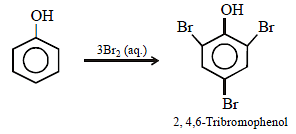JEE Advanced (Single Correct MCQs): Alcohols, Phenols & Ethers - JEE MCQ
20 Questions MCQ Test Chapter-wise Tests for JEE Main & Advanced - JEE Advanced (Single Correct MCQs): Alcohols, Phenols & Ethers
Ethyl alcohol is heated with conc H2SO4 the product formed is
Which of the following is basic
| 1 Crore+ students have signed up on EduRev. Have you? Download the App |
The compound which reacts fastest with Lucas reagent atroom temperature is (1981 - 1 Mark)
A compound that gives a positive iodoform test is(1982 - 1 Mark)
Diethyl ether on heating with conc. HI gives two moles of (1983 - 1 Mark)
An industrial method of preparation of methanol is : (1984 - 1 Mark)
When phenol is treated with excess bromine water, it gives: (1984 - 1 Mark)
HBr reacts fastest with : (1986 - 1 Mark)
Which of the following compounds is oxidised to preparemethyl ethyl ketone? (1987 - 1 Mark)
Phenol reacts with bromine in carbon disulphide at lowtemperature to give (1988 - 1 Mark)
Chlorination of toluene in the presence of light and heatfollowed by treatment with aqueous NaOH gives(1990 - 1 Mark)
When phenol is reacted with CHCl3 and NaOH followed by acidification, salicyladehyde is obtained. Which of the
following species are involved in the above mentioned reaction as intermediate?
The compound that will react most readily with NaOH toform methanol is (2001S)
1-Propanol and 2-propanol can be best distinguished by (2001S)
The product of acid catalyzed hydration of 2-phenylpropeneis (2004S)
The best method to prepare cyclohexene from cyclohexanolis by using (2005S)
The increasing order of boiling points of the below mentioned alcohols is (2006 - 3M, –1)
(I) 1,2-dihydroxybenzene
(II) 1,3-dihydroxybenzene
(III) 1,4-dihydroxybenzene
(IV) Hydroxybenzene
In the reaction  the products are
the products are
For the identification of b-naphthol using dye test, it isnecessary to use (JEE Adv. 2014)
|
447 docs|930 tests
|
|
447 docs|930 tests
|




 groups show positive iodoform test.
groups show positive iodoform test.
































